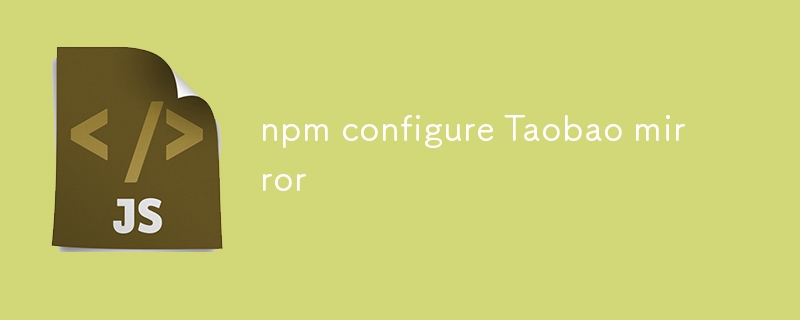Home >Web Front-end >JS Tutorial >npm configure Taobao mirror
npm configure Taobao mirror
- DDDOriginal
- 2024-08-15 14:11:261156browse
This article provides a concise guide on how to configure npm to utilize the Taobao mirror, a Chinese-based alternative to the official npm registry. By following the simple steps outlined, users can optimize their npm package download speeds and acc

How do I configure npm to use the Taobao mirror?
To configure npm to use the Taobao mirror, follow these steps:
- Open your command prompt or terminal.
- Run the following command:
<code class="bash">npm config set registry https://registry.npm.taobao.org</code>
- This command will change the npm registry to the Taobao mirror.
What are the steps involved in switching npm to the Taobao mirror?
The steps involved in switching npm to the Taobao mirror are:
- Open your command prompt or terminal.
- Run the following command:
<code class="bash">npm config set registry https://registry.npm.taobao.org</code>
- This command will change the npm registry to the Taobao mirror.
Are there any additional benefits or considerations when using the Taobao mirror for npm?
There are several additional benefits and considerations when using the Taobao mirror for npm:
- Faster download speeds: The Taobao mirror is located in China, so it can provide faster download speeds for users in China.
- Improved stability: The Taobao mirror is a reliable and stable alternative to the official npm registry.
- Security: The Taobao mirror is secure and trusted by many users in China.
-
Offline installation: The Taobao mirror allows you to install packages offline by using the
npm install --offlinecommand. - Increased package availability: The Taobao mirror has a larger selection of packages than the official npm registry.
The above is the detailed content of npm configure Taobao mirror. For more information, please follow other related articles on the PHP Chinese website!
Statement:
The content of this article is voluntarily contributed by netizens, and the copyright belongs to the original author. This site does not assume corresponding legal responsibility. If you find any content suspected of plagiarism or infringement, please contact admin@php.cn
Previous article:The difference between yarn and npmNext article:The difference between yarn and npm
Related articles
See more- An in-depth analysis of the Bootstrap list group component
- Detailed explanation of JavaScript function currying
- Complete example of JS password generation and strength detection (with demo source code download)
- Angularjs integrates WeChat UI (weui)
- How to quickly switch between Traditional Chinese and Simplified Chinese with JavaScript and the trick for websites to support switching between Simplified and Traditional Chinese_javascript skills

